Mission Report from Widescreen Weekend 1996
|
This article first appeared in The 70mm Newsletter |
| Article and pictures by: Thomas Hauerslev | Issue 44, April 1996 |
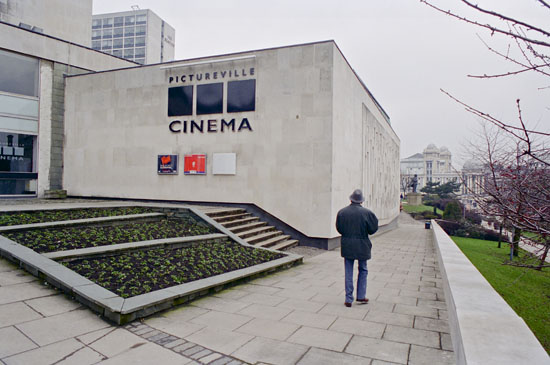 I was invited to join the Bradford Wide
Screen Festival as guest by senior film programmer Mr Bill Lawrence.
Eagerly awaiting to go in March 1996 I tried to prepare myself to see
3-strip Cinerama for the first time in my life as well as Todd-AO
projected on a louvered Cinerama screen. I have read about wide screen
processes for the past 15 years but never expected to finally see
Cinerama as originally projected on a 146 degree screen. I was very
exited when I left Copenhagen a sunny Friday morning bound for Bradford. I was invited to join the Bradford Wide
Screen Festival as guest by senior film programmer Mr Bill Lawrence.
Eagerly awaiting to go in March 1996 I tried to prepare myself to see
3-strip Cinerama for the first time in my life as well as Todd-AO
projected on a louvered Cinerama screen. I have read about wide screen
processes for the past 15 years but never expected to finally see
Cinerama as originally projected on a 146 degree screen. I was very
exited when I left Copenhagen a sunny Friday morning bound for Bradford.I arrived in Bradford 7 hours later, ready to see what the week-end would bring. Would I meet some members of the 70mm Association? How can The 70mm Newsletter and Bill Lawrence work more closely together with the aim of promoting 70mm film? Would it be possible take pictures of Pictureville cinema? What will the Cinerama screen look like from different angles etc, etc. Many questions were pondering my imagination. Without knowing any of the answers I found my tickets in the box-office for the performances of the week-end. And what a week-end! I had tickets for "This is Cinerama", "Those Magnificent Men...", Hello, Dolly!", and "How The West Was Won". I also managed to squeeze in "Blue Planet" and "Survival Island" on the giant IMAX screen. The only one in Britain. |
Further
in 70mm reading: Widescreen Weekend 1996 • Gallery: 1996 • WSW Home • Through the Years • The Best of WSW • Academy of the WSW • Creating the WSW • Planning the WSW • Projecting the WSW • Home of CINERAMA • Projecting CINERAMA Internet link: |
 After checking into the hotel I soon found myself in one of the
comfortable seats of Pictureville. The first film was
"Those
Magnificent Men..." in Todd-AO shown on the giant louvered
screen. The print was faded a bit but it did not seem to matter at all.
The important things was that it was shown to an enthusiastic audience.
After the film I went to a local Italian restaurant to dine with Jean
Pierre Gutzeit from Berlin and his friend Hans. We had a lovely chat
about 70mm film. Mr Gutzeit is of the opinion that 70mm prints of the
60es are much sharper than today’s standard. They were more
3-dimensional 30 years ago. Without having a print and a projector
between plates an cutlery we settled for the lasagne which was very
good. After dinner, the Germans had to find a hotel. I fell asleep quite
quickly after the experiences of the first day. After checking into the hotel I soon found myself in one of the
comfortable seats of Pictureville. The first film was
"Those
Magnificent Men..." in Todd-AO shown on the giant louvered
screen. The print was faded a bit but it did not seem to matter at all.
The important things was that it was shown to an enthusiastic audience.
After the film I went to a local Italian restaurant to dine with Jean
Pierre Gutzeit from Berlin and his friend Hans. We had a lovely chat
about 70mm film. Mr Gutzeit is of the opinion that 70mm prints of the
60es are much sharper than today’s standard. They were more
3-dimensional 30 years ago. Without having a print and a projector
between plates an cutlery we settled for the lasagne which was very
good. After dinner, the Germans had to find a hotel. I fell asleep quite
quickly after the experiences of the first day. |
|
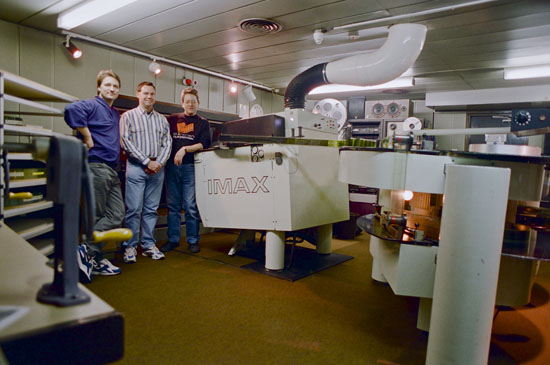 Thomas
Hauerslev, ? and Dick Vaughan, Head of IMAX Projection Thomas
Hauerslev, ? and Dick Vaughan, Head of IMAX ProjectionAfter a refreshing nights sleep I looked forward to the English breakfast. Hot tomatoes, sausages, eggs, bacon and tea as well as some corn flakes to remind me of home. After a short walk in Bradford down-town, I suddenly found myself inside the IMAX projection room with Mr Dick Vaughn, the projectionist. This IMAX projector is the oldest in Europe and the 15,9 x 19,4 metres screen (depth of curvature 3,28 metres) is the largest screen in England. I could not resist the temptation to see "Blue Planet". With the space cinematography it is one of the most stunning IMAX productions I have ever seen. |
|
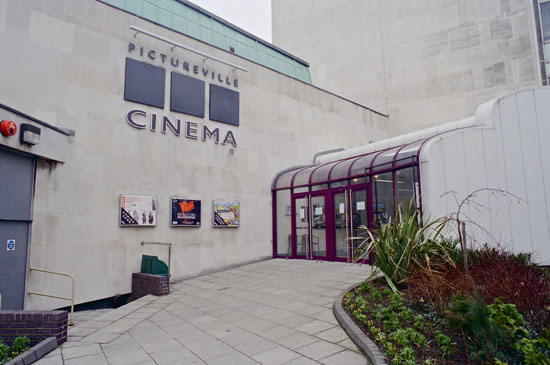 At 12 noon I had an appointment at Pictureville with the projectionist
staff; Mr Tony Cutts and Mr Duncan McGregor. Thanks to the corporation
of Bill Lawrence of NMPFT I was allowed to take a few rolls of film of
the unique 3-strip equipment in Pictureville. I spent the better part of
two hours running around with my tripod and Nikon
Vista Vision
camera trying to cover every considerable angle of the Pictureville
cinema. If the projectionist crew did know me, they would surely think
that I had lost my senses. Well possibly, but I managed to shoot 30
stills of the Cinerama screen as well as speakers, projection room
equipment, foyer and the crew and I in front of the screen. At 12 noon I had an appointment at Pictureville with the projectionist
staff; Mr Tony Cutts and Mr Duncan McGregor. Thanks to the corporation
of Bill Lawrence of NMPFT I was allowed to take a few rolls of film of
the unique 3-strip equipment in Pictureville. I spent the better part of
two hours running around with my tripod and Nikon
Vista Vision
camera trying to cover every considerable angle of the Pictureville
cinema. If the projectionist crew did know me, they would surely think
that I had lost my senses. Well possibly, but I managed to shoot 30
stills of the Cinerama screen as well as speakers, projection room
equipment, foyer and the crew and I in front of the screen.Before the next film I met with Mr Francois CARRIN of France. We bought some supplies in the restaurant and was finally ready to see "This is Cinerama". Francois came all the way from France. He had left the same morning in his own Mercedes through the tunnel en route to Bradford. Also present at this performance were 70mm Association members Mr Peter Andren & Mr Richard Liljendahl of Sweden of whom both I know well, David Page and Terry Later whom I had not met before and finally Mr Ben Wales of whom the members are very familiar thanks to his informative articles in the 70mm Newsletter. |
|
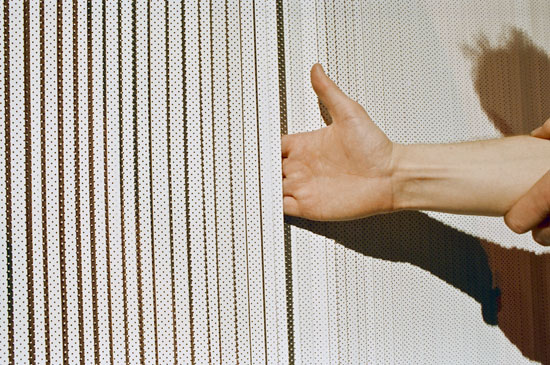 CINERAMA
louvered screen CINERAMA
louvered screenBill Lawrence introduced the film and then "the mother of all wide screen" systems began. To an almost full house it was amazing to see Wallers Wonder. After so many years of study, I could finally see this piece of history before my eyes. The join lines which I had read and heard so much about, was a very welcome sight. They sort of guarantied "the real thing". They belong to this system. Somewhere I read, for true Cinerama enthusiasts, it is all part of the show to notice the hard work the DOP have done to hide the lines. I must agree. The only flaw was the print, a new Eastman color print struck a few years ago especially for Bradford, however, the color grading left much to be desired. In some scenes the colours were awful and in others they were perfect. Hopefully, the NMPFT will get a better print in the future. Before the next film, one person among the audience had brought one 70mm reel of "Porgy and Bess" along. Not seen publicly for the better part of 35 years, no thanks to the Gershwin Estate who have filed legal action to prevent exhibition of the film in the future (Source: "Wide Screen Movies"), the audience had a rare opportunity to hear and see the musical number "It Ain’t Necessarily So" sung by Mr Sammy Davis, Jr. The sound was good. True magnetic 6- track fidelity. The sound spectrum was lovely. As a professional projectionist I am well aware of digital sound, but true 6-track magnetic stereo SOUNDS, well, like film. |
|
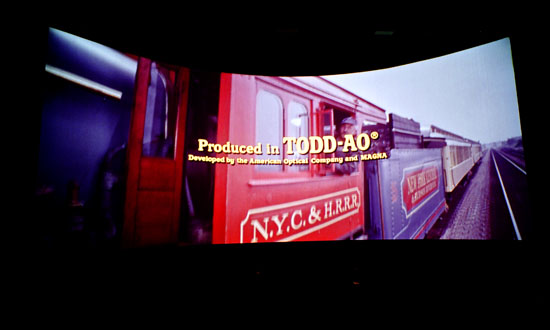 Only familiar with the music from
"Hello,
Dolly!", I looked forward to see the film. It turned out to a
delightful and pleasant experience. "Hello, Dolly!" is
greatly underrated. It was the last really big Hollywood musical. It
arrived, however, in a time when people were tired of traditional
musicals of this sort. The dance sequences are lovely, the songs are
great and the acting is entertaining. Described as
dreadful "Hello,
Dolly!" did cost a lot of money and 20th Century Fox almost
went bankrupt, again. During the intermission there were a slight
buzzing among the audience. I had a chance to meet Mr Jean Pierre
Vershure from Belgium. Mr Versure is a 35mm sound system enthusiast and
also member of the 70mm Association. Only familiar with the music from
"Hello,
Dolly!", I looked forward to see the film. It turned out to a
delightful and pleasant experience. "Hello, Dolly!" is
greatly underrated. It was the last really big Hollywood musical. It
arrived, however, in a time when people were tired of traditional
musicals of this sort. The dance sequences are lovely, the songs are
great and the acting is entertaining. Described as
dreadful "Hello,
Dolly!" did cost a lot of money and 20th Century Fox almost
went bankrupt, again. During the intermission there were a slight
buzzing among the audience. I had a chance to meet Mr Jean Pierre
Vershure from Belgium. Mr Versure is a 35mm sound system enthusiast and
also member of the 70mm Association. |
|
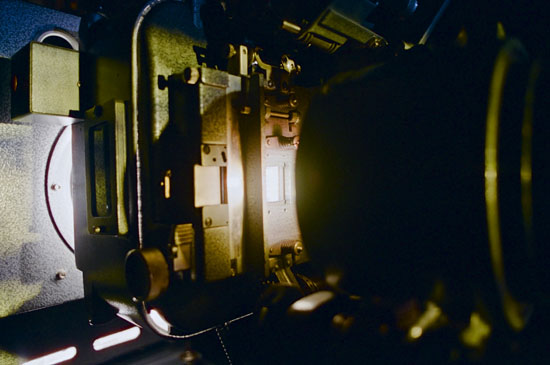 The last film on the programme that Saturday was
"How The West
Was Won" in 3-strip Cinerama. Perhaps the most eagerly awaited
performance of the wide screen section of the Bradford Film Festival.
The performance Saturday night was attended by quite a few people.
Pictureville cinema was almost sold out. Only a few seats were left.
Prior to this particular performance most of the audience had had a look
inside the projection room to see and smell the reels of
"How
The West Was Won". The print itself was one of the original IB
Technicolor prints from the original release 34 years earlier. This was
Cinerama print number 22 from Germany. Titles and 35mm soundtrack were
in German. However, from a Belgian fellow, an English spoken soundtrack
was provided. Tony and Duncan, the projectionist staff of Pictureville,
had both spent more than 40 hours making the English soundtrack match
the German Cinerama print. Many evenings after the regular show and a
few nights too, were spent running this 3-strip print. The print was
found in a German cinema in Essen a few years ago and is now stored at
Pictureville. The colours are in good condition (IB Technicolor), but
the print itself is not expected to hold for many performances. The
English soundtrack suffers from the vinegar syndrome and is
deteriorating. Hopefully many people will get the chance to see the film
as originally intended at Pictureville before it is over. The last film on the programme that Saturday was
"How The West
Was Won" in 3-strip Cinerama. Perhaps the most eagerly awaited
performance of the wide screen section of the Bradford Film Festival.
The performance Saturday night was attended by quite a few people.
Pictureville cinema was almost sold out. Only a few seats were left.
Prior to this particular performance most of the audience had had a look
inside the projection room to see and smell the reels of
"How
The West Was Won". The print itself was one of the original IB
Technicolor prints from the original release 34 years earlier. This was
Cinerama print number 22 from Germany. Titles and 35mm soundtrack were
in German. However, from a Belgian fellow, an English spoken soundtrack
was provided. Tony and Duncan, the projectionist staff of Pictureville,
had both spent more than 40 hours making the English soundtrack match
the German Cinerama print. Many evenings after the regular show and a
few nights too, were spent running this 3-strip print. The print was
found in a German cinema in Essen a few years ago and is now stored at
Pictureville. The colours are in good condition (IB Technicolor), but
the print itself is not expected to hold for many performances. The
English soundtrack suffers from the vinegar syndrome and is
deteriorating. Hopefully many people will get the chance to see the film
as originally intended at Pictureville before it is over. |
|
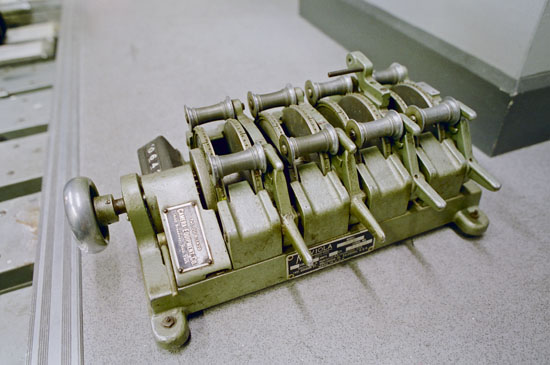 Mr Bill Lawrence, senior film programmer at NMPFT, introduced the
performance and told the story of how the staff had worked hard to make
this work. There was a big applaud for Tony and Duncan from the
audience, and Bill Lawrence continued that without the
International
Cinerama Rumour Factory this show would never had taken place. The
audience, now VERY eager to see the film, was greeted welcome once more,
and the show began. The first thing I noticed was the tape hiss. This is
really a thing of the past, but to me, tape hiss spells MAGNETIC SOUND.
And then, 7 tracks of stereophonic music bursted out of the speakers.
"I
Am Bound For The Promised Land" and many more by Mr Alfred
Newman in the overture can make a grown man cry. This was real
STEREO.
Modern 6-track mixes are 6-track mono compared to this. This was
a complete different sensation. A very nice sense of being
present. Mr Bill Lawrence, senior film programmer at NMPFT, introduced the
performance and told the story of how the staff had worked hard to make
this work. There was a big applaud for Tony and Duncan from the
audience, and Bill Lawrence continued that without the
International
Cinerama Rumour Factory this show would never had taken place. The
audience, now VERY eager to see the film, was greeted welcome once more,
and the show began. The first thing I noticed was the tape hiss. This is
really a thing of the past, but to me, tape hiss spells MAGNETIC SOUND.
And then, 7 tracks of stereophonic music bursted out of the speakers.
"I
Am Bound For The Promised Land" and many more by Mr Alfred
Newman in the overture can make a grown man cry. This was real
STEREO.
Modern 6-track mixes are 6-track mono compared to this. This was
a complete different sensation. A very nice sense of being
present.Big Film. Big Screen. Big Emotions. Most of the audience had seen the film before many years ago and a lot of emotions, feelings and love for the cinema, and especially for Cinerama, swept through the audiences that night. Most of the audience who had seen the film before never believed they were ever going to see "How The West Was Won" again in 3-strip Cinerama. When the film was over, we all applauded once more. Interestingly, a large part of the end was actually footage from "This Is Cinerama" only, it was shown backwards. |
|
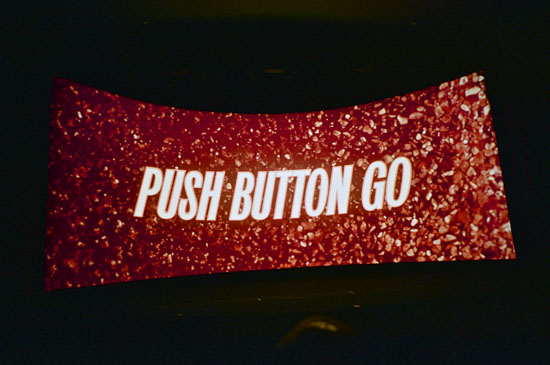 "Shellarama"
/ "Push Button Go" "Shellarama"
/ "Push Button Go"Then some of us "Skidaddled", to use a James Stewart phrase, to the nearest place where we could get something to eat. There we were, Mr Andren and Mr Liljendahl from Sweden, Mr Vershure and wife from Belgium, Mr CARRIN from France and myself from Denmark sitting in The Kashmir Restaurant eating Asian cuisine, in Britain talking about the American Sensurround system and old German 35mm sound heads in the middle of the night. Can it be more international? Some would probably say that we are crazy. Possibly, but we are happy. The next morning, which happened to be my 33rd birthday, was also in the sign of Cinerama. Many of the guests from the day before, turned up again to see "How The West Was Won" once more. Before the show, there was a screening of the short film "Shellerama"/"Push Button Go" in 70mm. The print was badly faded and very hard to keep in focus. The Sunday performance were nearly sold out too. I managed to see the main titles again to feel the rush. It was time for me to get back to Denmark. The last film for me was "Survival Island" in IMAX which I saw together with Francois from France. After the film I took the train to Kings Cross in London. I was very tired. |
|
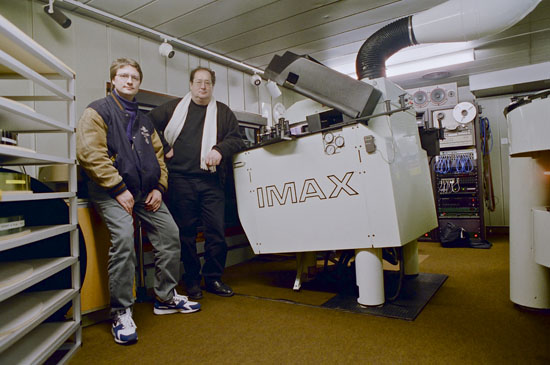 Thomas
Hauerslev and Francois Carrin Thomas
Hauerslev and Francois CarrinSeeing old prints, faded clips, looking for join lines, the smell of magnetic sound, hearing tape hiss, seeing "Intermission" signs, is all part of the show in Bradford. I was fortunate to see a few films, but the programme were even larger. The following 70mm titles were also shown "Apocalypse Now", "War And Peace", "Around The World In 80 Days" and the 1956 Todd-AO short "The Miracle Of Todd-AO". The week-end in Pictureville came to an end. I owe much thanks to the staff there, especially Mr Bill Lawrence, Mr Tony Cutts, Mr Duncan McGregor and Mr. Dick Vaughan for making it unforgettable, highly interesting and for making me feel so welcome. |
|
|
Go:
back
- top
-
back issues
- news index Updated 22-01-25 |
|
